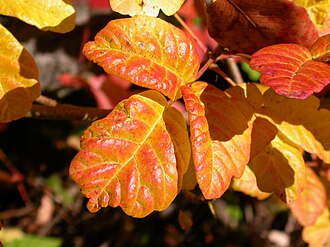Binomial Name: Toxicodendron diversilobum
Description: Western Poison-oak is extremely variable in growth habit and leaf appearance. It grows as a dense shrub in open sunlight, or as a climbing vine in shaded areas. Like Poison ivy, it reproduces by creeping rootstocks or by seeds. The leaves are divided into 3 leaflets, 3½ to 10 centimeters long, with scalloped, toothed, or lobed edges- generally resembling the leaves of a true oak, though the Western Poison-oak leaves will tend to be more glossy. Leaves are generally bright green in the spring (or bronze when first unfolding), yellow-green to reddish in the summer, and bright red or pink in the fall. White flowers form in the spring and, if fertilized, develop into greenish- white or tan berries.
Where found: Western Poison-oak or Pacific Poison-oak (Toxicodendron diversilobum) is found only on the Pacific Coast of the United States and of Canada. It is extremely common in that region, where it is the predominant species of the genus
WARNING: All parts of this plant contain urushiol, which can cause severe dermatitis in some individuals. See the entry under Poison Ivy for more details.
|

Western Poison Oak showing its fall colors
|